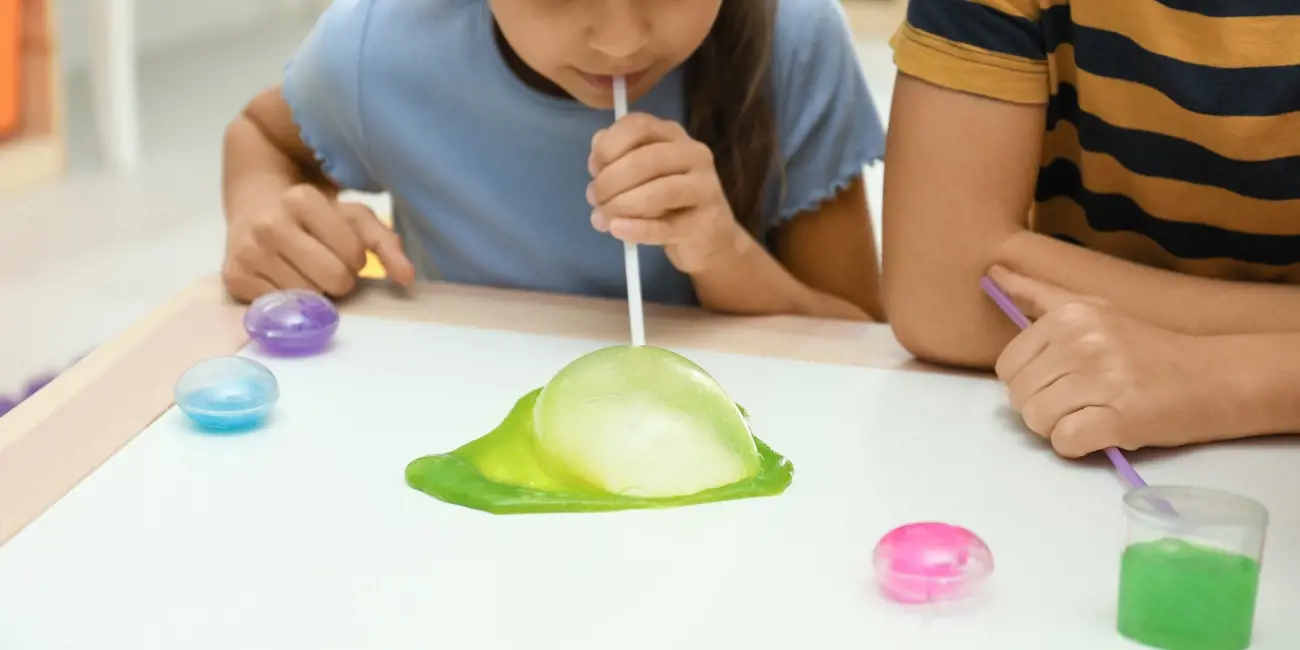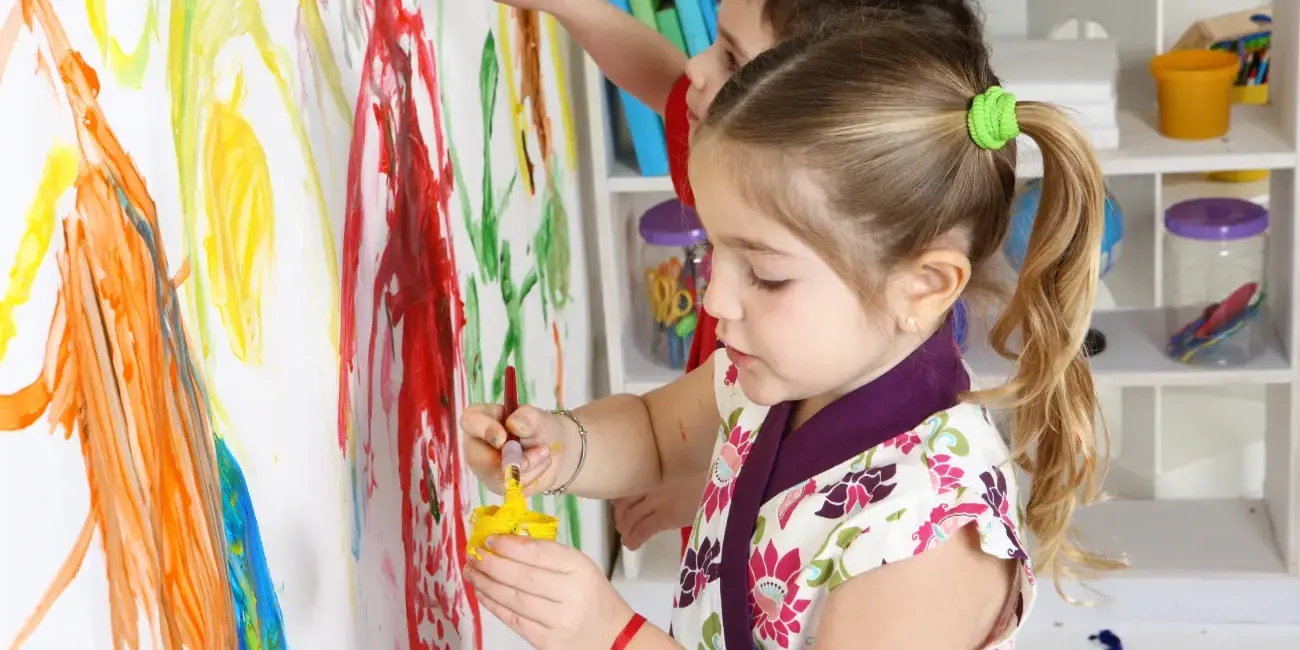Some parents can come up with creative projects at the drop of a paintbrush, but if you’re not exactly oozing with inspiration, then don’t worry!
Heather Flyght runs Li’l Crafters art and craft classes, and she knows how to ignite young children’s curiosity, develop their skills, and have stacks of fun with simple materials and beautiful projects.
Ms. Flyght has a Diploma in Fine Arts, years of experience working in childcare, and two daughters of her own, and this week she’s kindly explaining ways for every baby, toddler, preschooler, and parent to find the creativity within.
Good news for uncrafty parents
If a parent wants to put together a craft supplies bin but doesn’t know where to start, what materials do you recommend for under-fives?
The good news is that you don’t need to spend loads of cash on quality art supplies for this age group.
Kids aged five and under benefit from a mix of sensory materials, basic art supplies (that can be used in a variety of ways) and recyclables found around the home. Instead of using posh paints, it’s all about exposing your child to new and different materials and textures, encouraging exploration, and offering invitations to craft or play. So, I recommend that you start with these basic art and craft supplies, then grow from there:
- Homemade play dough
- A watercolour palette
- Child-sized scissors
- Oil pastels
- A pad of watercolour paper (Kmart sells a cheap, good quality option)
- Washi tape
- A bottle of kid’s craft glue with a squeezy nozzle, because little ones love to squeeze, and this is a great way to develop fine motor skills
- Poster paint, which can be watered down to make it go further
- Recyclables from around the home, including egg cartons, cardboard boxes, and plastic lids. These bits and pieces are like gold to a crafty child and you can use them to make robots, treasure chests, sculptures, and anything they think up
- A coloured rice sensory play tub; and
- Shaving foam, because it makes for awesome sensory fun. You can add paints and then paint with it, make marble prints with liquid watercolors, and also add toy cars, dinosaurs, or baby dolls for a foamy play session.
Keeping it simple
What are some simple, but fun, craft projects that non-crafty parents can do with young children?
To all of you self-proclaimed 'non-crafty parents' out there, the first step is letting go of your need to ‘know’ how to do this. Crafts might not be your thing and that's ok.
The best thing about making art with kids is that you are merely there to set up, observe, pass the materials when needed, and clean up!
The magic happens when you offer your child some materials and ideas about how they could be used, then see where they take them.
My favourite easy set-ups to offer are:
- Tape-resist watercolour painting
- Magic potions, using water, food colouring, flowers, leaves, bicarbonate soda, and vinegar
- Play dough all day, every day! Mix it up by adding small parts, like cupcake cases, small rocks, nature bits, dinosaurs, etc
- Cardboard sculptures. Cut out different shapes using cardboard from your recyclables, cut small slits around the sides of each piece, and decorate your cardboard using crayons, oil pastels, textas, etc. Then, using the slits, connect the pieces to make cool, easy sculptures; and
- Collage pictures. Use cut-up magazine images, old artworks, and bits of newspaper and coloured paper to make a new masterpiece.

Age appropriate fun
What are your favourite age-specific projects for babies, toddlers, and preschoolers?
Babies aren’t ready to make a project as such, but they can start to explore the feeling of materials. For instance, ‘Is it wet, cold, squishy, and soft? What happens if I touch it, dip my finger in it, and put it in my mouth? Do I like that feeling or not?’
The secret for babies is to keep it simple, engaging, and safe, so water play is my number one creative play activity for bubs.
All you need to do is fill buckets and tubs with water, throw in some kitchen funnels and strainers, cups, and so on, then let them sit and splash, pour, wash a baby doll, or clean a dinosaur. This is hours of entertaining fun for bubs, especially when the weather warms up.
Toddlers are so curious and like to test the boundaries in life and art! There's nothing I love more than offering a toddler a large, interesting canvas to paint on. The ‘canvas’ can be a big piece of cardboard, a flattened box, or a large piece of fabric (e.g. an old tablecloth or drop sheet) and I recommend that you give your toddler different tools to paint with, including roller brushes, a spray bottle, and a fly swat!
This kind of painting gives your child ‘permission’ to explore, go big, incorporate movement into their work and test the boundaries – all of which appeals to toddlers!
Preschoolers are ready and want to learn more art and craft skills, and I have so many favourite activities, it's hard to choose just one … So, I’m not going to! Instead, I'm going to suggest a few simple crafts that never disappoint a preschooler:
- Cardboard moveable robots
- Fabric weaving using a simple cardboard loom
- Playdough small world lands
- Nature mandala sun catchers using sticky contact paper
- Collage multimedia, using paper, glue, markers, and/or paints; and
- Creative cardboard masks
Nurturing development
On the developmental side of things, how do art and craft help children learn and practice core skills?
These hands-on, brain-on activities help children develop in lots of key ways. For starters:
- Creative projects develop and strengthen kids’ fine motor skills, e.g. when they hold a paintbrush, grip a pencil, and do other things that use the small muscles in their hands
- Art and craft nurture their creativity
- They learn their colours, numbers, and shapes, and practice their sorting skills
- Creative projects develop kids’ cognitive and social skills, e.g. when they think about colour mixing, share art materials, or take turns showing off their work
- Children get to use their planning skills, e.g. when they consider what step to do next or how they want the project to turn out
- They practice their bilateral coordination, which means using both sides of the body at the same time; and
- Kids learn how to problem-solve
Sustainability is sensible
What are some eco-friendly, nature-based activities you love?
I love incorporating nature into art and craft projects whenever possible! It can be as easy as doing a nature hunt and making potions with leaves, flowers, water, and food colouring.
Painting with nature is always a hit, too. You use leaves and branches as your paintbrush and notice the different textures. Leaf printing, which involves painting leaves and pressing them onto paper, is also fantastic, and I love nature mandalas!
Slime is very popular with children, but it often contains large amounts of PVA glue and Borax. What eco-friendly gloop can you recommend instead of slime?
If your kiddo loves all things slimy and gooey, but you’re not keen on using the unfriendly ingredients that are in most slime recipes, then oobleck is the way to go.
It brings all the sensory, slimy, goopy goodness without the nasties.
Be inspired
How do you get inspiration for your own L’il Crafters classes?
I do find inspiration everywhere – it’s all around us!
I find that I'm often inspired by the materials I have at hand. If I find an awesome deal at my local recycle centre, Reverse Garbage, or at an art shop, then I'll come up with an activity or craft that’s inspired by the material.
I follow lots of process art and craft studios and like-minded individuals on Instagram, and I often re-do classic projects, but add a twist (although sometimes there's no need to reinvent the wheel!).
I’m always immersing myself in nature, and travel is inspiring, too, but most of all, my kids inspire me and they often come up with awesome ways to make something that I never would have thought of!
































